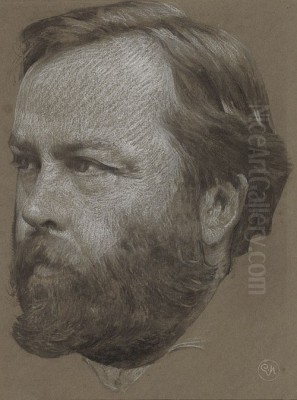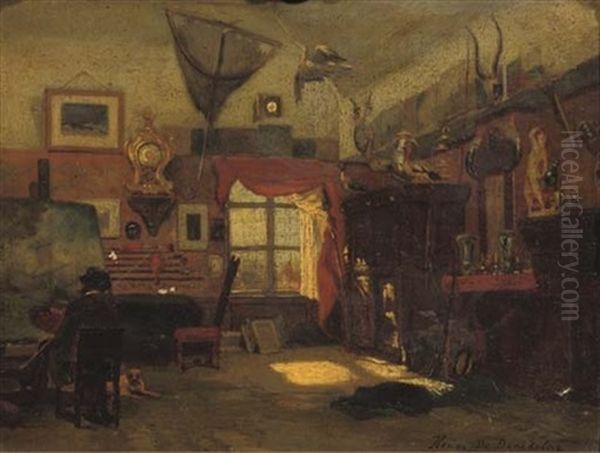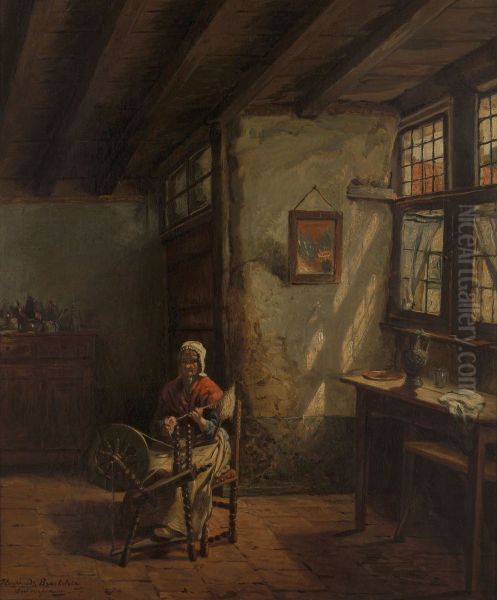
Henri Jean Augustin de Braekeleer (1840-1888) stands as a pivotal yet often underappreciated figure in Belgian art. Working during a transformative period in European art history, he carved a unique niche for himself, focusing on intimate interior scenes, imbued with a profound sensitivity to light, color, and atmosphere. While his contemporaries were exploring the grand narratives of history painting or the fleeting impressions of outdoor light, De Braekeleer turned his gaze inward, capturing the quiet poetry of everyday life in his native Antwerp. His work forms a bridge between the rich traditions of Flemish and Dutch Golden Age painting and the burgeoning currents of modernism, making him a significant precursor to later developments in Belgian art.
Early Life and Artistic Formation in an Artistic Milieu
Born in Antwerp on June 11, 1840, Henri de Braekeleer was destined for a life in art. He hailed from a family deeply embedded in the artistic fabric of the city. His father, Ferdinand de Braekeleer the Elder, was a respected painter of historical and genre scenes, providing young Henri with his initial artistic instruction. Further guidance came from his uncle, Baron Henri Leys, a dominant figure in Belgian Romanticism and historical painting. Leys, known for his meticulous detail and revival of 16th and 17th-century Flemish techniques, exerted a considerable influence on his nephew's early development.
Under Leys's tutelage, De Braekeleer absorbed a respect for craftsmanship, historical accuracy, and the power of narrative. Leys's studio was a hub of artistic activity, and his emphasis on reviving a national artistic identity through historical subjects resonated deeply in mid-19th century Belgium. De Braekeleer's early works, therefore, often reflected these influences, touching upon historical, biographical, and emotionally charged themes, executed with a precision and attention to detail learned from his esteemed mentors. However, even in these formative years, a distinctive sensibility began to emerge, one that would eventually lead him down a more personal and introspective path.
The Allure of Antwerp: A City as Muse

Antwerp, with its rich history and well-preserved old quarters, was more than just a backdrop for De Braekeleer; it was a central character in his artistic narrative. He was deeply drawn to the city's past, particularly its "Golden Age" in the 16th and 17th centuries. This fascination manifested in his choice of settings: the dimly lit interiors of old guild houses, artisan workshops, and quiet domestic spaces that seemed to whisper tales of bygone eras. His paintings often evoke a sense of nostalgia, a quiet contemplation of time's passage, and the enduring presence of history within the everyday.
Unlike many of his contemporaries who sought inspiration in Paris or the Italian countryside, De Braekeleer found his universe within the familiar streets and interiors of Antwerp. He meticulously documented the city's character, not through grand vistas, but through the intimate portrayal of its inhabitants and their environments. Works like The Old Inn at Antwerp (1877) capture this sentiment, presenting a scene steeped in local color and a palpable sense of lived history. This focus on the local and the specific, rendered with universal emotional resonance, became a hallmark of his mature style.
The Dutch Golden Age Revisited: A Pilgrimage and Its Impact
A pivotal moment in De Braekeleer's artistic journey was his visit to the Netherlands in 1863. There, he encountered firsthand the masterpieces of the Dutch Golden Age painters, particularly Johannes Vermeer and Pieter de Hooch. This experience was transformative. He was profoundly struck by their mastery of light, their serene depiction of domestic interiors, and their ability to elevate everyday scenes to a level of poetic intensity. Vermeer's luminous interiors, with their solitary figures bathed in window light, and De Hooch's complex spatial arrangements and views through successive rooms, left an indelible mark on De Braekeleer's artistic vision.
This influence is readily apparent in his subsequent work. He began to explore similar themes: quiet figures engaged in simple tasks, rooms illuminated by a soft, diffused light, and a meticulous attention to the textures and surfaces of objects. Like Vermeer, De Braekeleer became a connoisseur of light, studying its subtle gradations, its ability to define form, and its power to evoke mood. He also absorbed De Hooch's skill in creating convincing perspectival depth and his interest in the interplay between interior and exterior spaces, often suggested through open doors or windows. While artists like Gerard ter Borch and Gabriel Metsu also excelled in Dutch genre scenes, it was the particular qualities of light and intimate atmosphere in Vermeer and De Hooch that most resonated with De Braekeleer.
Light as the Protagonist: A Unique Visual Language

For Henri de Braekeleer, light was not merely an element of composition; it was often the central subject of his paintings. He possessed an extraordinary ability to capture the nuances of light – the way it filtered through a dusty windowpane, illuminated a corner of a room, or glinted off the surface of a polished object. His interiors are never static; they are alive with the subtle play of light and shadow, creating a palpable atmosphere that envelops the figures and objects within. This preoccupation with light aligns him with some of the concerns of the Impressionists, such as Claude Monet or Camille Pissarro, though his approach was distinctly his own.
De Braekeleer developed a technique that has sometimes been described as a "pseudo-pointillism" or a form of broken color. Rather than smooth, blended surfaces, he often applied paint in small, distinct touches, allowing colors to mix optically in the viewer's eye. This method, while not as systematic as the Neo-Impressionism of Georges Seurat or Paul Signac, contributed to the vibrancy and luminosity of his surfaces. It allowed him to convey the shimmering quality of light and the richness of textures with remarkable subtlety. He would often paint the same subject multiple times, exploring different light conditions and angles, demonstrating his deep investigation into the optical effects of light and color.
Key Themes and Representative Masterpieces
De Braekeleer's oeuvre is characterized by a consistent focus on specific themes, primarily the depiction of Antwerp's daily life through its interior spaces. His subjects were the artisans, the shopkeepers, and the quiet inhabitants of the city's older quarters. He painted tailors, coppersmiths, printers, and ordinary people in their homes, capturing moments of quiet industry or contemplation.
Among his most celebrated works is The Man in the Chair (circa 1876), also known as The King Drinks. This painting, depicting a figure seated in a richly decorated interior, showcases his mastery of light, texture, and psychological nuance. The warm glow illuminating the room, the intricate details of the furnishings, and the introspective mood of the subject are characteristic of his best work. Another significant piece, The Man at the Window (circa 1887), exemplifies his Vermeer-like fascination with figures positioned near a light source, creating a poignant sense of solitude and reflection.
Other notable works include The Laundry (Van Cutsem collection), which transforms a mundane domestic task into a scene of quiet beauty through its delicate light and harmonious color palette. The Coppersmith's Workshop (Vleeshouwer collection) provides a glimpse into the world of Antwerp's craftsmen, rendered with an appreciation for the dignity of labor and the textures of the workshop environment. The Geographer and The Printer's Workshop further illustrate his interest in scenes of focused activity within carefully constructed interior spaces. These paintings are not merely descriptive; they are imbued with a quiet, poetic quality that invites contemplation.
Challenges, Recognition, and Connections
Despite his undeniable talent, De Braekeleer's career was not without its challenges. He was described as a solitary and somewhat reclusive individual, and he reportedly suffered from periods of mental illness, which may have contributed to a somewhat "chaotic" career trajectory. This introspective nature, however, likely fueled his deep focus on the intimate and the personal in his art.
During a crucial period from 1869 to 1873, De Braekeleer benefited from a contract with the Brussels art dealer Gustave Coûteaux. This arrangement provided him with financial stability and allowed him to produce a significant body of work, leading to greater public recognition, including gold medals at exhibitions in Brussels and Vienna. His unique vision also caught the attention of fellow artists. Notably, Vincent van Gogh, in an 1885 letter to his brother Theo, praised De Braekeleer's work, expressing admiration for his innovative style and his ability to convey atmosphere. This acknowledgment from an artist as perceptive as Van Gogh underscores De Braekeleer's quiet impact.
While deeply influenced by the Dutch Golden Age, De Braekeleer was also a man of his time. His work can be seen in dialogue with the broader Realist movement, exemplified by artists like Gustave Courbet or Jean-François Millet, in its focus on everyday life. However, De Braekeleer's realism was less about social commentary and more about capturing a timeless, poetic essence. His meticulous technique and historical sensibility also connect him to the academic traditions upheld by artists like Jean-Léon Gérôme, though his subject matter was far removed from Gérôme's exotic Orientalism or grand historical reconstructions.
A Quiet Modernist: Legacy and Influence
Henri de Braekeleer's position in art history is complex. He was not a radical innovator in the mold of the French Impressionists, nor did he align himself with the dramatic gestures of Romanticism. Yet, his intense focus on light, his subjective interpretation of reality, and his exploration of the psychological dimensions of interior space mark him as an important precursor to modernism in Belgium. He, along with artists like Alfred Stevens, who painted elegant Parisian interiors, helped to shift the focus of Belgian art towards more contemporary and personal themes.
His influence can be felt in the work of later Belgian artists. While James Ensor, a near contemporary, would take Belgian art in a more expressionistic and fantastical direction, and Fernand Khnopff would explore the enigmatic realms of Symbolism (often through evocative interiors), De Braekeleer's legacy lies in his quiet insistence on the profound beauty of the ordinary. His dedication to capturing the "soul" of a place and its people through the subtle interplay of light and shadow resonated with a particular strain of Belgian modernism that valued intimacy and introspection. One might even see a distant echo of his sensibility in the later Intimist works of French painters like Edouard Vuillard or Pierre Bonnard, who similarly found rich artistic material in the depiction of domestic interiors and the emotional lives of their inhabitants.
Despite his achievements and the admiration of discerning contemporaries like Van Gogh, De Braekeleer did not achieve widespread international fame during his lifetime. His work remained relatively little known outside Belgium until later reassessments, such as a significant exhibition in 1988, which helped to solidify his reputation. He died relatively young, on July 20, 1888, in his beloved Antwerp.
Conclusion: The Enduring Light of Henri de Braekeleer
Henri de Braekeleer was a painter of quiet moments and luminous spaces. He found his artistic voice not in grand pronouncements but in the subtle observation of the world around him. His paintings of Antwerp interiors are more than just records of a time and place; they are meditations on light, memory, and the enduring human presence within the everyday. Drawing inspiration from the Dutch masters like Vermeer and De Hooch, and filtering it through his own unique sensibility and the artistic currents of the 19th century, he created a body of work that is both deeply personal and universally resonant. As an art historian, one recognizes in De Braekeleer a master of atmosphere, a poet of light, and a crucial figure in the development of modern Belgian art, whose subtle genius continues to illuminate. His legacy is a testament to the power of art to find the extraordinary within the ordinary, and to capture the timeless essence of a place and its people.